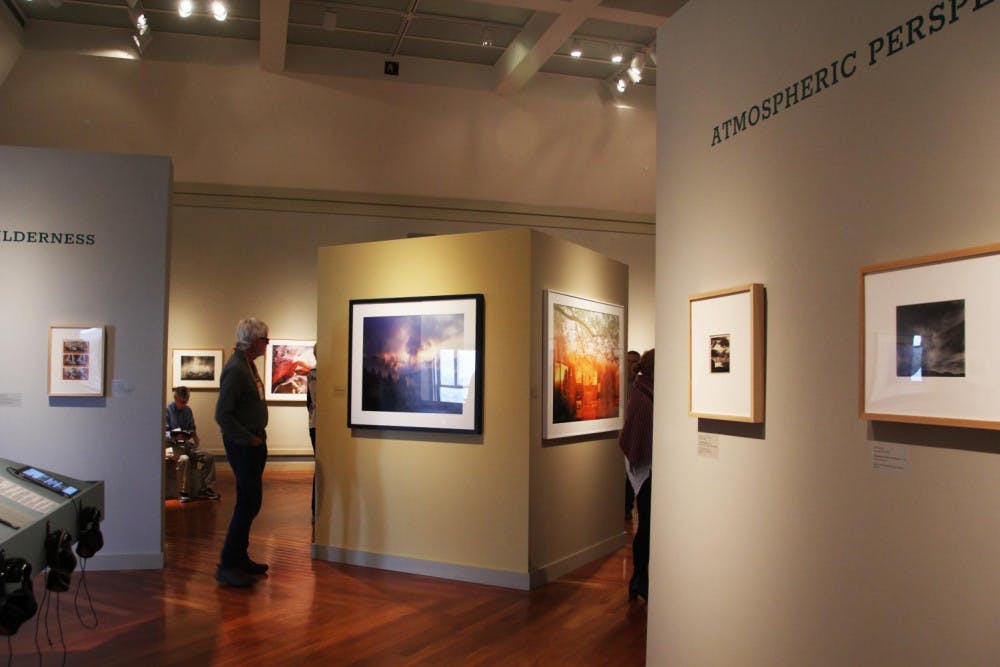Currently on display in the Middlebury College Museum of Art until Dec. 10 is “Land and Lens: Photographers Envision the Environment.” A selection of 71 images, “Land and Lens” draws heavily from the museum’s own rich collection of photographs that spans multiple centuries and includes work from such acclaimed photographers as Ansel Adams, Joel Meyerowitz and Eliot Porter.
“Our collection is particularly strong in photography, so it’s great to have an opportunity to showcase it,” said Kirsten Hoving, professor of art history and guest curator of the exhibition.
The project has been a multi-year effort, and many students worked on the exhibition in the years leading up to this semester, either in Hoving’s classes on photography and the environment or as student interns and research assistants.
Housed in the beautiful second-floor showroom of the museum in the Mahaney Center for Fine Arts, the exhibition tastefully assembles the collected works in small, related groups that successfully highlight both the actual content of the photographs and the immaculate quality of their prints. The photos are divided based on their theme and content into eight different sub-categories that explore the many different landscapes of Earth and beyond, from the bare expanses of the Greenland ice sheet, to inflamed oil wells in the heart of the Niger Delta and all the way to the stars that quietly illuminate the Eagle Nebula.
The images in the exhibition are visually beautiful and meticulously composed without exception, and while all of them are impressive in their own ways, more than a few of these photographs are downright stunning. One of the photographs on display is Ansel Adams’ famous “Monolith – The Face of Half Dome” from his “Paramelian Prints of the High Sierras” collection. Taken in 1927, Adams’ black and white image of Yosemite’s Half Dome expertly manipulates light and filters to give the intimidating rock face an ominous shadow and is considered to be one of his first masterpieces. The gelatin silver print of “Monolith” resides here at Middlebury College. To put this in perspective for those who are not photography geeks, Adams was not just some guy with an Instagram account or an amateur photographer who somehow coerced the Middlebury Museum of Art into buying a two-bit print. Adams was a highly-respected purveyor of landscapes in the American West, documenting the natural beauty of the region with the fervor and passion of an ardent environmentalist and earning him the Presidential Medal of Freedom, the highest civilian honor in the United States, from President Jimmy Carter in 1980. Therefore, the fact that the Museum has a print of one of Adams’ masterpieces on display is quite impressive.
“Land and Lens” also boasts a feature that I had personally never experienced before in a photography gallery: an entirely digital, all-inclusive catalogue that accompanies the works on display in the exhibit. Professor Hoving and her students created a comprehensive directory that provides everything from background information on the image and artist to student-made musical interpretations of the photographs that amplify the power of the viewing experience. In the exhibit itself, there is a stand with multiple sets of iPads where visitors can access this information. The catalogue is also available on smartphones and personal tablets.
“Land and Lens” is a beautiful, fascinatingly human exhibition. The groupings of pictures titled “Wilderness” and “Cosmos” examine mankind’s place among nature and the stars, respectively. “Troubled Waters” and “Fenced, Farmed, Mined” question our connection to the environment and our effect on it. “The Built Environment” and “Power Dynamics” paint an ominous and captivating portrait of the darker side of modern industry. This collection of images, elite in their composition, framing and beauty, accompanies the issues that they present, make “Land and Lens: Photographers Envision the Environment” a tremendous exhibition certainly worth one’s tim




